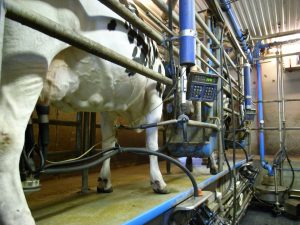1.4.2. Public Health
Protecting Public Health
Most foodborne infections go unreported and undiagnosed. For example, the (U.S.) CDC estimates that about seventy-six million people in the United States become ill from foodborne pathogens or other agents every year. In North America, a number of government agencies work to educate the public about food infections and intoxications, prevent the spread of disease, and quell any major problems or outbreaks. They include the CDC, the FDA, and the USDA, among other Canadian organizations.
Efforts on the Governmental Level
A number of government agencies work to ensure food safety and to protect the public from foodborne illness. Food regulatory agencies work to protect the consumer and ensure the safety of our food including production, processing, packaging.
The (US) FDA and agencies of Health Canada oversee many food-related issues including the safety of domestic and imported foods, policies and monitoring of agricultural practices such as animal and crop safety, food safety research and education programs for farmers and consumers. It They also monitor supplements, food labels, claims that corporations make about the benefits of products, and pharmaceutical drugs.
Government agencies also conduct environmental assessment, education, research, and regulation and work to prevent pollution and protect natural resources. Two among many regulatory practices in the area of agriculture include overseeing water quality and the use of pesticides, approving pesticides and other chemicals used in agriculture and setting limits on how much residue can remain on food. Processing methods can either reduce or concentrate pesticide residue in foods.
The Food System

The food system is a network of farmers and related operations, including food processing, wholesale and distribution, retail, industry technology, and marketing. The milk industry, for example, includes everything from the farm that raises livestock, to the milking facility that extracts the product, to the processing company that pasteurizes milk and packages it into cartons, to the shipping company that delivers the product to stores, to the markets and groceries that stock and sell the product, to the advertising agency that touts the product to consumers. All of these components play a part in a very large system.
Two important aspects of a food system are preservation and processing. Each provides for or protects consumers in different ways. Food preservation includes the handling or treating of food to prevent or slow down spoilage. Food processing involves transforming raw ingredients into packaged food, from fresh-baked goods to frozen dinners. Although there are numerous benefits to both, preservation and processing also pose some concerns, in terms of both nutrition and sustainability.
Food Irradiation: What You Need To Know
Irradiation does not make foods radioactive, compromise nutritional quality, or noticeably change the taste, texture, or appearance of food. In fact, any changes made by irradiation are so minimal that it is not easy to tell if a food has been irradiated.
Food irradiation (the application of ionizing radiation to food) is a technology that improves the safety and extends the shelf life of foods by reducing or eliminating microorganisms and insects. Like pasteurizing milk and canning fruits and vegetables, irradiation can make food safer for the consumer.
Why Irradiate Food?
Irradiation can serve many purposes.
- prevention of foodborne illness: to effectively eliminate organisms that cause foodborne illness, such as Salmonella and E. coli.
- preservation: to destroy or inactivate organisms that cause spoilage and decomposition and extend the shelf life of foods.
- control of insects: to destroy insects in or on tropical fruits imported into the United States. Irradiation also decreases the need for other pest-control practices that may harm the fruit.
- delay of sprouting and ripening: to inhibit sprouting (e.g., potatoes) and delay ripening of fruit to increase longevity.
- sterilization: irradiation can be used to sterilize foods, which can then be stored for years without refrigeration. Sterilized foods are useful in hospitals for patients with severely impaired immune systems, such as patients with AIDS or undergoing chemotherapy. Foods that are sterilized by irradiation are exposed to substantially higher levels of treatment than those approved for general use.
Is Irradiated Food Safe to Eat?
The FDA has evaluated the safety of irradiated food for more than 30 years and has found the process to be safe.
The World Health Organization (WHO), the Centers for Disease Control and Prevention (CDC) and the U.S. Department of Agriculture (USDA) have also endorsed the safety of irradiated food.
Figure 1.4.2.1 Radura Symbol

How Will I Know if My Food Has Been Irradiated?
Look for the Radura symbol along with the statement “Treated with radiation” or “Treated by irradiation” on the food label.
It is important to remember that irradiation is not a replacement for proper food handling practices by producers, processors, and consumers. Irradiated foods need to be stored, handled, and cooked in the same way as non-irradiated foods, because they could still become contaminated with disease-causing organisms after irradiation if the rules of basic food safety are not followed.[1]
Food Processing
Food processing includes the methods and techniques used to transform raw ingredients into packaged food. Workers in this industry use harvested crops or slaughtered and butchered livestock to create products that are marketed to the public. There are different ways in which food can be processed, from a one-off product, such as a wedding cake, to a mass-produced product, such as a line of cupcakes packaged and sold in stores.
The Pros and Cons of Food Processing

Food processing has a number of important benefits, such as creating products that have a much longer shelf life than raw foods. Also, food processing protects the health of the consumer and allows for easier shipment and the marketing of foods by corporations. However, there are certain drawbacks. Food processing can reduce the nutritional content of raw ingredients. For example, canning involves the use of heat, which destroys the vitamin C in canned fruit. Also, certain food additives that are included during processing, such as high fructose corn syrup, can affect the health of a consumer. However, the level of added sugar can make a major difference. Small amounts of added sugar and other sweeteners, about 6 to 9 teaspoons a day or less, are not considered harmful.[2]
Food Additives
If you examine the label for a processed food product, it is not unusual to see a long list of added materials. These natural or synthetic substances are food additives and there are more than three hundred used during food processing today. The most popular additives are benzoates, nitrites, sulfites, and sorbates, which prevent molds and yeast from growing on food.[3] Food additives are introduced in the processing stage for a variety of reasons. Some control acidity and alkalinity, while others enhance the color or flavor of food. Some additives stabilize food and keep it from breaking down, while others add body or texture. Table 1.4.2.1 “Food Additives” lists some common food additives and their uses:
Table 1.4.2.1 Food Additives
| Additive | Reason for adding |
| Beta-carotene | Adds artificial colouring to food |
| Caffeine | Acts as a stimulant |
| Citric acid | Increases tartness to prevent food from becoming rancid |
| Dextrin | Thickens gravies, sauces, and baking mixes |
| Gelatin | Stabilizes, thickens, or texturizes food |
| Modified food starch | Keeps ingredients from separating and prevents lumps |
| MSG | Enhances flavor in a variety of foods |
| Pectin | Gives candies and jams a gel-like texture |
| Polysorbates | Blends oil and water and keep them from separating |
| Soy lecithin | Emulsifies and stabilizes chocolate, margarine, and other items |
| Sulfites | Prevent discoloration in dried fruits |
| Xanthan gum | Thickens, emulsifies, and stabilizes dairy products and dressings |
Source: Chemical Cuisine: Learn about Food Additives. Center for Science in the Public Interest.http://www.cspinet.org/reports/chemcuisine.htm. Published 2012. Accessed January 20, 2018.
There are numerous foods additives that are added to processed and prepackaged foods. The consumption of these should be kept to a minimum.
The Pros and Cons of Food Additives
Food additives are typically included in the processing stage to improve the quality and consistency of a product. Many additives also make items more “shelf stable,” meaning they will last a lot longer on store shelves and can generate more profit for store owners. Additives can also help to prevent spoilage that results from changes in temperature, damage during distribution, and other adverse conditions. In addition, food additives can protect consumers from exposure to rancid products and foodborne illnesses.
Food additives aren’t always beneficial, however. Some substances have been associated with certain diseases if consumed in large amounts. For example, the (U.S.) FDA estimates that sulfites can cause allergic reactions in 1 percent of the general population and in 5 percent of asthmatics. Similarly, the additive monosodium glutamate, which is commonly known as MSG, may cause headaches, nausea, weakness, difficulty breathing, rapid heartbeat, and chest pain in some individuals.[4]
The Effect of New Technologies
As mentioned earlier, new technology has had a tremendous effect on the food we eat and the customs and culture related to food consumption. For example, microwaves are used to reduce cooking time or to heat up leftover food. Refrigerators and freezers allow produce to travel great distances and last longer. On the extreme end of making food last longer, there is special food for astronauts that is appropriate for consumption in space. It is safe to store, easy to prepare in the low-gravity environment of a spacecraft, and contains balanced nutrition to promote the health of people working in space. In the military, soldiers consume Meals Ready-to-Eat (MREs), which contain an entire meal in a single pouch.
Genetically Modified Foods (GMOs)
Genetically modified foods (also known as GM or GMO foods), are plants or animals that have undergone some form of genetic engineering. In the United States, much of the soybean, corn, and canola crop is genetically modified. The process involves the alteration of an organism’s DNA, which allows farmers to cultivate plants with desirable characteristics.[5] For example, scientists could extract a gene that produces a chemical with antifreeze properties from a fish that lives in an arctic region (such as a flounder). They could then splice that gene into a completely different species, such as a tomato, to make it resistant to frost, which would enable farms to grow that crop year-round.[6]
Certain modifications can be beneficial in resisting pests or pesticides, improving the ripening process, increasing the nutritional content of food, or providing resistance to common viruses. Although genetic engineering has improved productivity for farmers, it has also stirred up debate about consumer safety and environmental protection. Possible side effects related to the consumption of GM foods include an increase in allergenicity, or tendencies to provoke allergic reactions. There is also some concern related to the possible transfer of the genes used to create genetically engineered foods from plants to people. This could influence human health if antibiotic-resistant genes are transferred to the consumer. Therefore, the World Health Organization (WHO) and other groups have encouraged the use of genetic engineering without antibiotic-resistance genes. Genetically modified plants may adversely affect the environment as well and could lead to the contamination of non-genetically engineered organisms.[7]
- Food Irradiation. U.S. Food and Drug Administration. https://www.fda.gov/food/resourcesforyou/consumers/ucm261680.htm. Updated January 4, 2018. Accessed January 18, 2018. ↵
- Sugar and Carbohydrates. American Heart Association. http://www.heart.org/HEARTORG/GettingHealthy/NutritionCenter/HealthyDietGoals/Sugars-and-Carbohydrates_UCM_303296_Article.jsp#. Updated April 20, 2017. Accessed January 4, 2018. ↵
- The Dangers of Food Additives. How Stuff Works. http://health.howstuffworks.com/wellness/food-nutrition/facts/dangers-of-food-additives.htm. Accessed October 5, 2011. ↵
- The Issues: Additives. Sustainable Table. http://www.sustainabletable.org/issues/additives/#fn14. Accessed October 10, 2011. ↵
- What Are Genetically Modified Foods?. Genomics.Energy.gov. http://www.ornl.gov/sci/techresources/Human_Genome/elsi/gmfood.shtml. Last modified November 5, 2008. Accessed October 11, 2011. ↵
- Whitman DB. Genetically Modified Foods: Harmful or Helpful?. CSA Discovery Guides. 2000; 1-13. https://biomed.brown.edu/arise/resources/docs/GM%20foods%20review.pdf. Accessed January 20, 2018. ↵
- Food Safety: 20 Questions on Genetically Modified Foods. World Health Organization. http://www.who.int/foodsafety/publications/biotech/20questions/en/. Updated May 2014. Accessed January 18, 2018. ↵

